In a valley southeast of Phoenix, AZ the Gila River integrates from the mountains. The Gila River curves steeply southward towards the Gila Bend Mountains to the west side of Phoenix, then curves back eastward close to Gila Bend.
It is an essential water supply for many towns in the area and has a length of roughly 649 miles. This river features portions of Class I to III whitewater and several beautiful canyons. The Gila River is distinguished by unpredictable flows and flash floods that rise to towering heights and fall away just as swiftly because of its barren environment.
The Gila River is home to a broad variety of species of plants and animals because of its largely unspoiled status. It sustains a wide variety of aquatic species, including fish that are in danger of extinction, such as the Gila topminnow.
A popular site for bird watchers, the Gila River’s various ecosystems draw a wide range of bird species as well. One creature you’ll find in plenty around this portion of Arizona is snakes! Let’s take a look at all of the types of slithering serpents that are around the Gila River.
Snakes Around the Gila River
1. King Snake

California mountain kingsnakes are often mistaken for venomous coral snakes due to their bold colors
©Matt Jeppson/Shutterstock.com
There are a few types of king snakes that live near this area of Arizona. The California Kingsnake can be discovered in a wide variety of environments. You can find them in forests, grasslands, swamps, arid regions, and even in suburbs.
With the exception of the colder months, when they flee underground and go into a state known as brumation, these kingsnakes are typically discovered during daylight hours. The average adult is between 36 and 48 inches long.
The majority of them have pale stripes flowing down their bodies and are black or brown in color. In Arizona, mountains between 3,000 and 9,000 feet above sea level are where you’ll mostly find Sonoran Mountain Kingsnakes.
They thrive in rocky terrain, chaparral, coniferous woods, and juniper forests, and often appear alongside rivers and springs. At full maturity, they can grow up to 36 inches long. The easiest way to identify a Sonoran Mountain Kingsnake is by the head. The eyes are covered by a black stripe on their white head.
Despite their misleading moniker, desert kingsnakes frequent bodies of water. In dry regions, look for them next to water tanks and in river corridors. The average adult is between 36 and 48 inches tall. This snake is harmless and typically is gentle with humans. Fascinatingly, when approached by people, they typically turn over and pretend to be dead.
2. Gopher Snake

Gopher Snakes love to slither around dense vegetation.
©Jerry Kirkhart from Los Osos, Calif / CC BY 2.0 – License
One of the biggest snakes in Arizona are gopher snakes. It has been stated that they can grow up to 92 inches long! On average, this type of snake found near the Gila River is around four feet long! They typically have a beige or cream tint and are heavily patterned on the back and flanks with a series of smaller, similar-looking brown spots with black edges.
When the circumstances are right, they can be lively both during the day and at night. Although they prefer to be on the ground, they are impressive climbers and are occasionally spotted on trees.
Gopher snakes hiss vociferously, flatten their heads into a triangular form, and wave their tails at intruders if they feel threatened. They can occasionally be mistaken for a rattlesnake due to these habits and body characteristics.
3. Western Diamondback
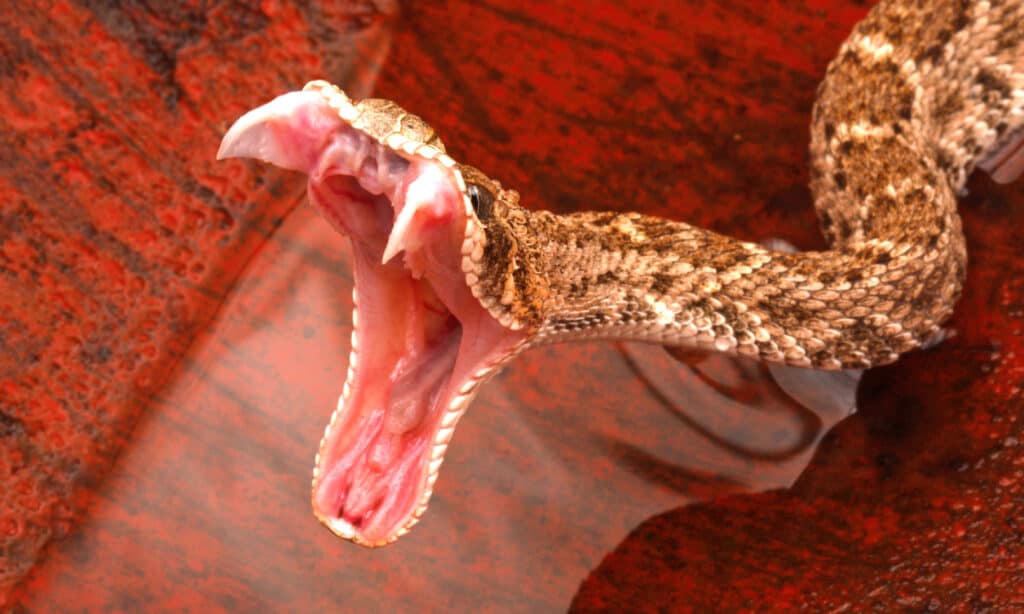
This type of rattlesnake can fold their teeth into their mouth when not in use.
©iStock.com/johnaudrey
The Western Diamondback Rattlesnake, which lives in several types of environments, is the snake that is most frequently seen in the Phoenix area. They are the most common snakes to be seen close to the Gila River. In Arizona, this type of snake can grow up to six feet long!
As the name implies, the serpent’s back is adorned in a variety of forms, some of which may resemble diamonds but are more frequently irregular ovals or curved rectangles. The diamonds are usually defined by a white or cream outline and are often darker than the rest of the color of the body.
The rattle on a Western Diamondback is unique and, given the snake’s general look and the tail’s starkly juxtaposed black and white lines, highly noticeable. The rattle often has a tan or hazy yellow tint. Their rattles are made from a brittle substance which is similar to human fingernails!
4. Mojave Rattlesnake
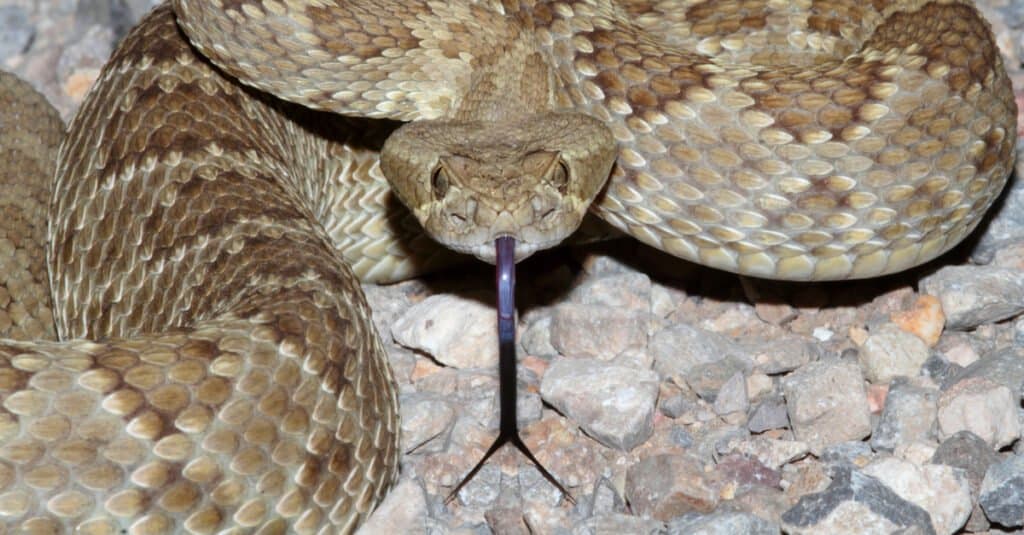
Many people believe the Mojave rattlesnake to be one of the deadliest snakes in Arizona.
©Steve Byland/Shutterstock.com
Although Mojave rattlesnakes typically live in the desert, you can find them near the shoreline of the Gila River. These serpents love any area that is open and airy, giving them plenty of room to slither.
Depending on its environment, the Mojave rattlesnake can range in color from brown to light green. These snakes are known as “Mojave greens” in some places because of the green color they have.
Because they spend most of their time at night hiding beneath stones or in the tunnels of various mammals, Mojave rattlesnakes aren’t commonly spotted. However, on chilly days, they could emerge throughout the day to enjoy the warmth of the sun. In the winter, these snakes brumate either individually or in small groups.
They are at their most active from April to September. These snakes are known for being hostile toward people when provoked. Like other wild animals, Mojave rattlesnakes will actively defend themselves.
5. Sidewinder
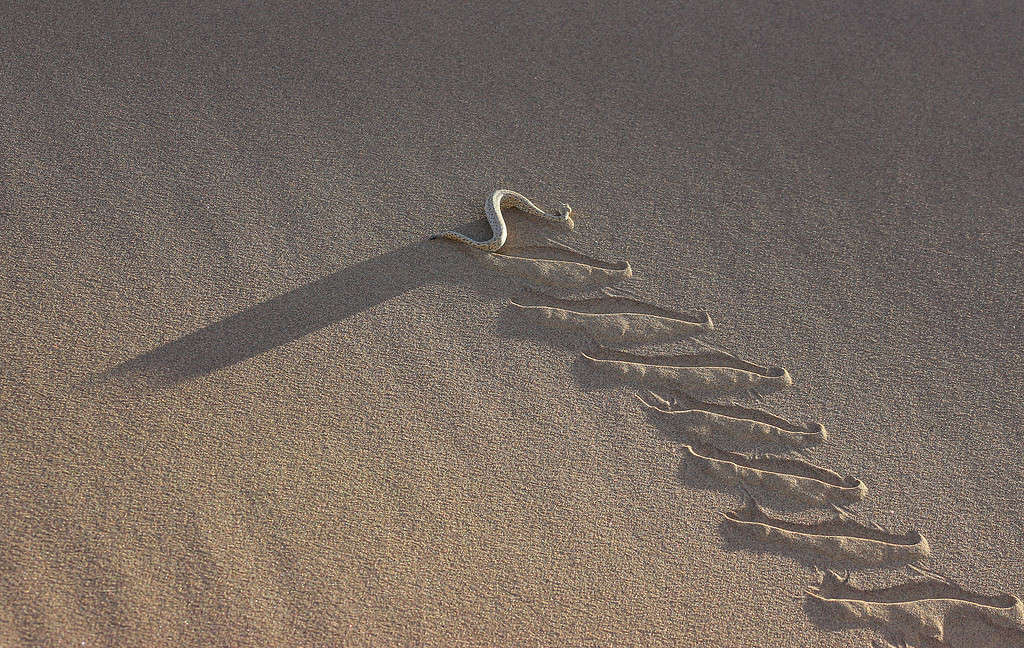
Because of the way they move, Sidewinders make unique tracks in the sand.
©Chantelle Bosch/Shutterstock.com
The area around the Gila River is relatively dry, yet has plenty of foliage. Although this type of snake isn’t in the area often, the Sidewinder is worth mentioning. They spend the majority of their time in the sand, yet are impressive swimmers!
Something else impressive about the Sidewinder is that it can slither up to 18 miles per hour. They get their name from the unique way that they move. Instead of slithering forward, they move side-to-side.
Metachrosis, a phenomenon where color changes in response to temperature, occurs in Sidewinders. Although these snakes are venomous, their venom is less potent than that of many other rattlesnakes.
They are less hazardous than their larger relatives as a result of this as well as the reduced size of their venom glands. Regardless, any rattlesnake bite should be handled seriously, and emergency medical assistance should be sought.
6. Southern Banded Rock Rattlesnake
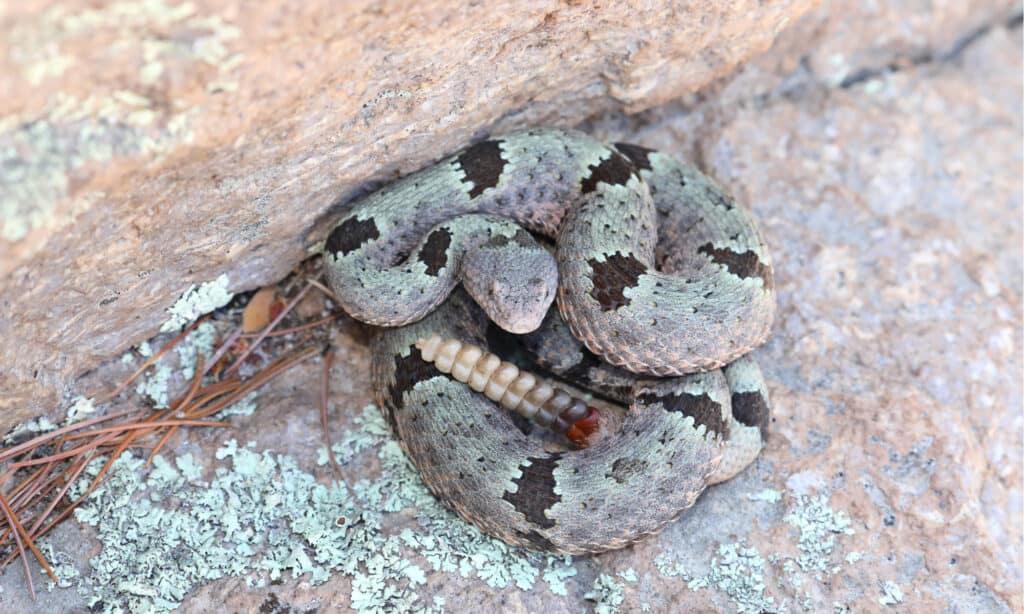
Banded rock rattlesnakes are one of the various types of banded rattlesnakes in the state.
©Glenn McCrea/Shutterstock.com
A venomous species, the banded rock rattlesnake can bite animals and people. Its entire body is a pale gray with thick, blackish-gray streaks along the entire length of it. Males and females of this species have different colors because they are sexually dichromatic.
Although few are capable of reaching 31 inches, banded rock rattlesnakes normally reach lengths of 27 inches. Their natural environments range from meadows and tropical evergreen woods to mountains, rocky plains, and vegetation near the Gila River.
They also live in arid and semi-arid settings. A banded rock rattlesnake may shake its tail when disturbed in an effort to fend off possible predators, just like other rattlesnake species do.
7. Blackneck Garter Snake
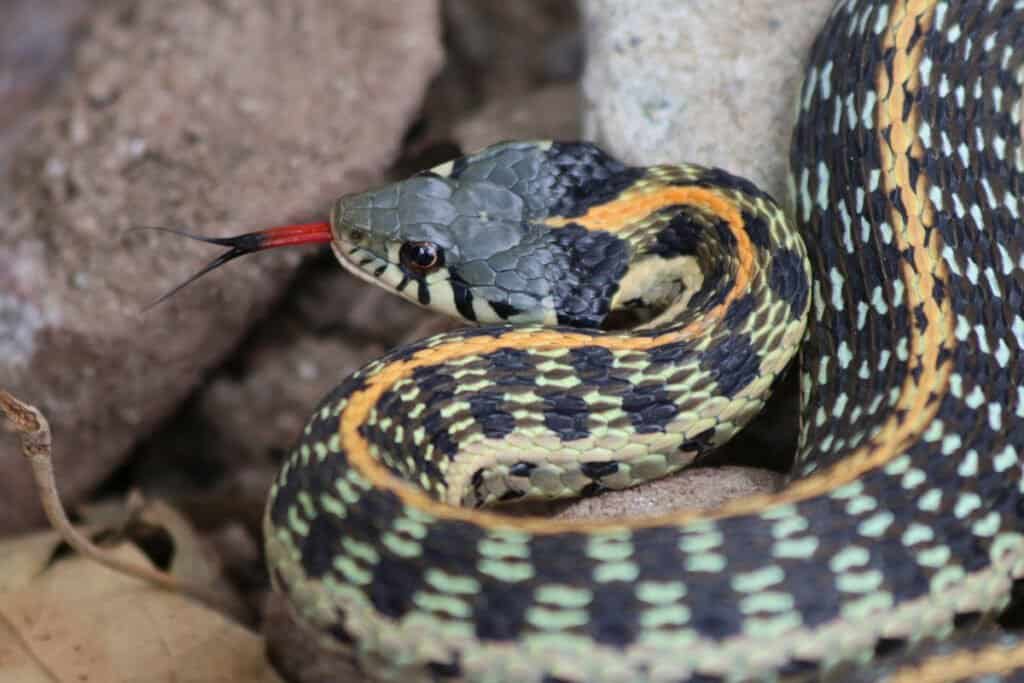
Blackneck Garter Snakes have a bright red tongue with a black tip.
©Creeping Things/Shutterstock.com
A garter snake species that is indigenous to North and Central America is the blackneck garter snake. It is non-venomous and may be encountered in a variety of environments, frequently close to water supplies.
Blackneck garter snakes can be seen moving around throughout the day, around dusk, and on occasion even at night. The majority of their time is spent near rivers, where Western blackneck garter snakes love to swim.
They spend a lot of their time hunting for food near the Gila River. On the other hand, eastern blackneck garter snakes often prefer to live their life on dry land close to a water supply.
Summary of the Snakes Around the Gila River
| Snake | Is it venomous? |
|---|---|
| King Snake | No |
| Gopher Snake | No |
| Western Diamondback | Yes |
| Mojave Rattlesnake | Yes |
| Sidewinder | Yes |
| Southern Banded Rattlesnake | Yes |
| Black-Necked Garter Snake | No |
The photo featured at the top of this post is © PhilBilly/iStock via Getty Images
Discover the "Monster" Snake 5X Bigger than an Anaconda
Every day A-Z Animals sends out some of the most incredible facts in the world from our free newsletter. Want to discover the 10 most beautiful snakes in the world, a "snake island" where you're never more than 3 feet from danger, or a "monster" snake 5X larger than an anaconda? Then sign up right now and you'll start receiving our daily newsletter absolutely free.
Thank you for reading! Have some feedback for us? Contact the AZ Animals editorial team.







